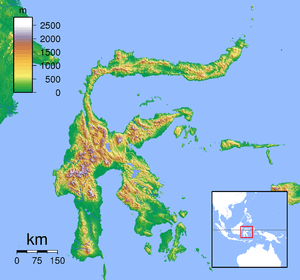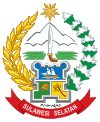Palopo
| Palopo | |
|---|---|
| City | |
| Motto: IDAMAN (Indah (Beautiful), Damai (Safe), Nyaman (Pleasant)) | |
 Palopo Location of Palopo in Sulawesi | |
| Coordinates: 3°0′S 120°12′E / 3.000°S 120.200°ECoordinates: 3°0′S 120°12′E / 3.000°S 120.200°E | |
| Country |
|
| Province | South Sulawesi |
| Founded | c. 1620 |
| Area | |
| • Total | 247.52 km2 (95.57 sq mi) |
| Population (2010 Census) | |
| • Total | 148,033 |
| • Density | 600/km2 (1,500/sq mi) |
| Time zone | WITA (UTC+8) |
| Area code(s) | +62 471 |
Palopo or Kota Palopo is one of the autonomous cities (municipalities) in South Sulawesi Province of Indonesia, and the third-largest city in the province. Until it acquired its autonomy, Palopo was the capital of Luwu Regency. The population of the city was 148,033 at the 2010 Census.[1]
History
Palopo was founded c. 1620, probably under the second Muslim ruler of Luwu Kingdom, Sultan Abdullah Muhiddin, who is buried at Malangke, the former palace centre of Luwu. His momental grave, which was carved with Majapahit-style floral decorations, was destroyed by Kahar Muzakkar rebels in the 1950s: nothing today remains except the location.[2] The advantage of Palopo over the former palace centre was the potential for trade with the Toraja-speaking Seko-Rongkong valleys. The town sits at the foot of a steep, winding pass which leads into the highland regions. In the late 19th century this trade consisted primarily of coffee and slaves.[3] Gold panned from upland rivers may also have been an attraction. Dammar was an important export in the later period.[4]
Little is known of Palopo before the Dutch annexation of South Sulawesi in 1905. The only Western visitor to have left an account of the town was James Brook (later Rajah of Sarawak), who described it in the 1830s as 'a miserable town, consisting of about 300 houses, scattered and dilapidated'.[5] It is the location of South Sulawesi's oldest mosque. Built from blocks of white coral, with a three-tiered roof representing the ancient Austronesian cosmos, the Mesjid Jami' is said to have been built during the reign of Sultan Abdullah. It has a 19th-century dedicatory inscription behind one of its doors, presumably reflecting a restoration. The royal graveyard lies to the north at Lokkoe and contains pyramidical stone mausolea in which lie the remains of Luwu's 17th to 20th-century rulers.
Administration
Palopo City is divided into nine Districts (Kecamatan), tabulated below with their 2010 Census population.[6]
| Name | Population Census 2010 |
|---|---|
| Wara Selatan | 10,124 |
| Sandana | 5,732 |
| Wara | 31,024 |
| Wara Timur (East Wara) | 30,997 |
| Mungkajang | 6,981 |
| Wara Utara (North Wara) | 19,011 |
| Bara | 22,959 |
| Telluwanua | 11,701 |
| Wara Barat (West Wara) | 9,403 |
References
- ↑ Biro Pusat Statistik, Jakarta, 2011.
- ↑ Van Lijf, J.M. 1953. 'Korte mededelingen.' Bijdragen tot de Taal-, Land- en Volkenkunde 109:379-81.
- ↑ Braam Morris, D.F. van. 1889. 'Het landschap Loewoe.' Tijdschrift voor Indische Taal-, Land- en Volkenkunde 32: 497-555; Zerner, C. 1981. 'Signs of the spirits, signature of the smith: Iron forging in Tana Toraja.' Indonesia 31: 89-112
- ↑ Caldwell, I. 1994. ‘Report on fieldwork.' Baruga 10:16-18.
- ↑ Brooke, J. 1848. Narrative of events in Borneo and Celebes down to the occupation of Labuan. From the Journals of James Brooke, Esq. Rajah of Sarawak and Governor of Labuan [. . .] by Captain Rodney Mundy. London: John Murray
- ↑ Biro Pusat Statistik, Jakarta, 2011.
